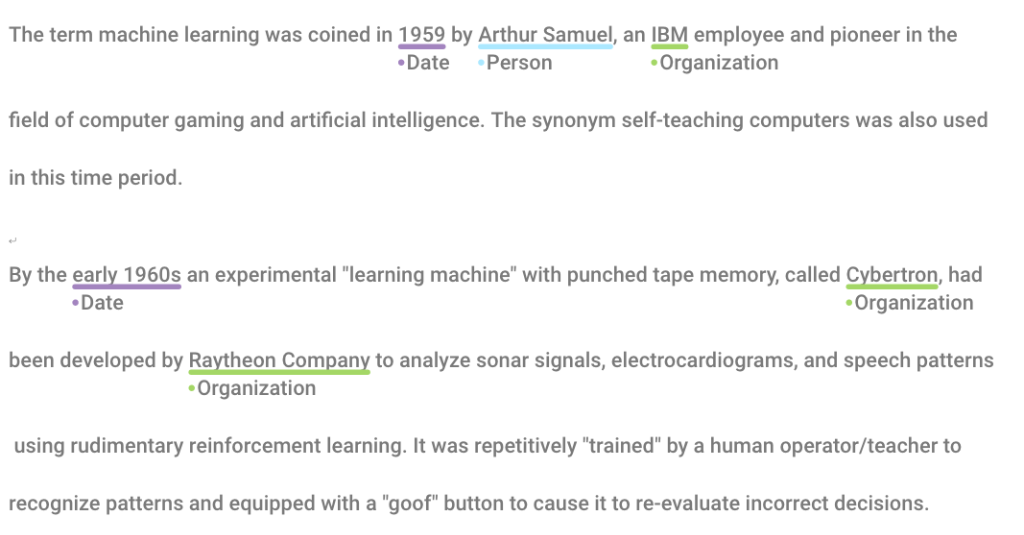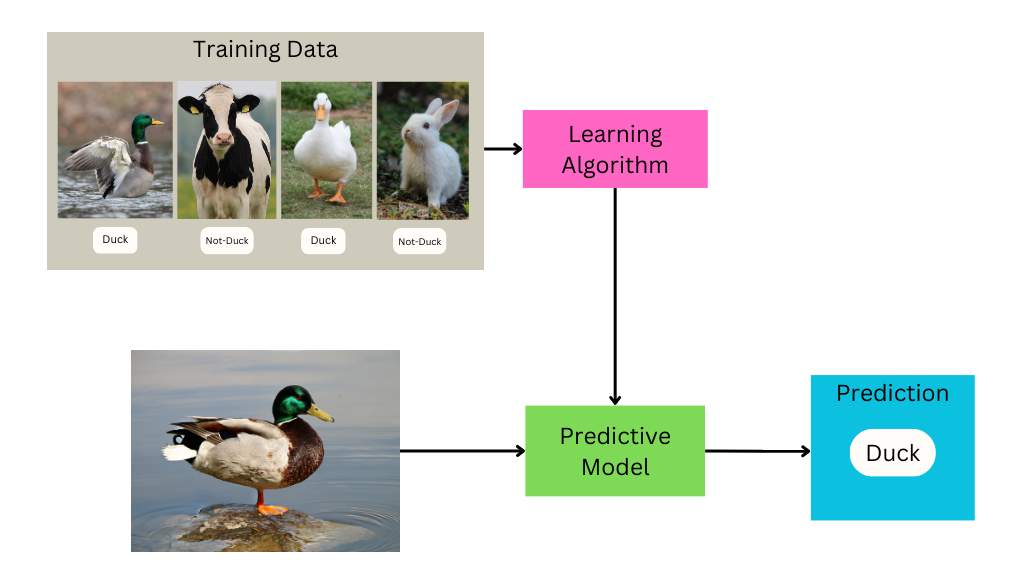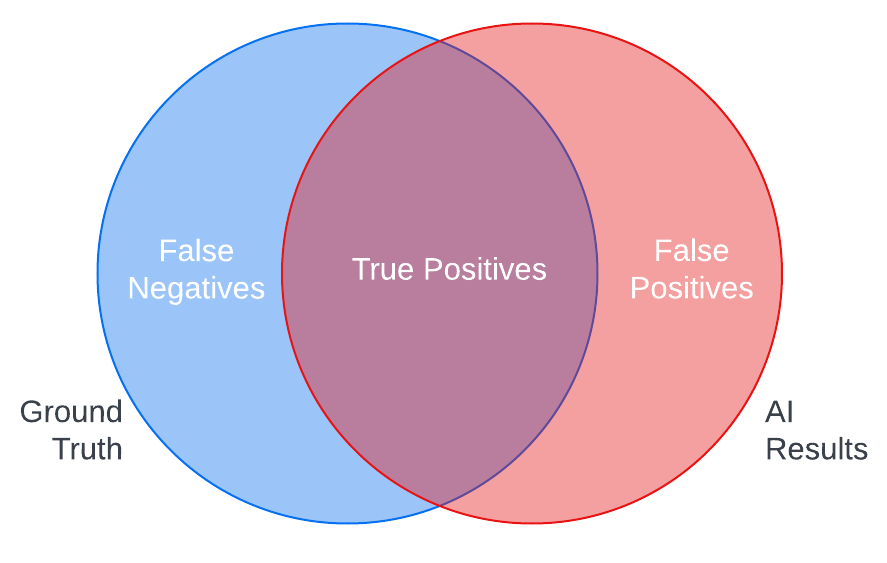AVP Select
Creating a successful DAM RFP
10 November 2023
In the world of digital asset management (DAM) system selection, requests for proposals (RFP) are ubiquitous. This is for good reason. A strong RFP includes a user-centered approach outlining priorities, usage scenarios, and requirements. It also provides vendors with an explanation of and context for technology needs, and clear instructions for their proposals. The RFP brings all of the details together in a way for organizations to perform apples-to-apples comparisons of vendor proposals.
In this post, we provide everything you need to get started on your RFP journey. You’ll learn what is unique about DAM RFPs, how to structure your RFP, and questions to ask vendors. Follow along on our downloadable DAM RFP checklist.

What is an RFP?
A Request for Proposal (RFP) is a business document, sometimes managed by a procurement or purchasing office (and sometimes not). RFPs announce an organization’s need for a new technology, detail the requirements for that technology, define its purpose, and solicit bids for the financial commitment for purchase.

RFPs allow qualified vendors to showcase their technology solutions and demonstrate how they align with those requirements. They act as a gateway for vendors to promote their expertise, capabilities, and innovative technologies to meet the needs of the organization.
It is important to note that RFPs are not mandatory in all contexts. However, they are commonly used in government settings to counteract favoritism, prejudice, and nepotism. RFPs level the playing field. They ensure that vendors are evaluated solely based on the quality of their proposals and the cost of investment. This approach promotes fairness and impartiality, allowing all vendors to compete on an equal footing. By eliminating biases and providing a transparent evaluation process, RFPs enable organizations to make informed decisions that prioritize the best interests of their stakeholders.

How do I create an RFP?
The good news is there are lots of examples of RFPs on the web. And, if you have a procurement office, you can always reach out to get examples of how your organization creates them.
That said, the examples you’ll find online are often generic, not specific to DAM selection. While generic RFP templates can be helpful starting points, they do not always provide insights into how to gather the information to complete the RFP, including business objectives, functional, technical, and format requirements, usage scenarios, and user profiles. All of these are necessary to provide vendors with a comprehensive understanding of your organization’s needs for new DAM technology.

What is unique about DAM RFPs?
Before we jump into the checklists, let’s take a moment to review what makes a DAM RFP unique. First, DAM selection projects will have many internal and external stakeholders. From marketing to creatives and archivists and their constituents, there are many perspectives to represent. It is key, then, that time is spent understanding their broad set of needs, through interviews, surveys, and focus groups.

The digital asset management market offers a multitude of options, with numerous systems available at varying price points and complexities. For organizations unfamiliar with the wide range of choices, sifting through these options can be a challenging endeavor, especially given the intricate nature of DAM systems. These systems often share common functionalities but also possess distinctive features that set them apart.
An RFP can provide your organization with a side-by-side comparison of the vendor proposals. This includes a qualitative comparison, but if done correctly, can offer a quantitative assessment, as well.
Factors to consider in DAM procurement
- Content-centric approach: DAMs focus on the challenges of organizing, managing, and distributing digital assets. By focusing on the content itself, DAM systems enhance the accessibility, searchability, and utilization of digital assets. DAMs make it easier for users to find and work with the specific content they need.
- Emphasis on metadata and taxonomy: A successful DAM will enable effective search, discovery, and retrieval of digital assets. It will categorize and describe assets with rich metadata and a structured taxonomy. This ensures users can quickly locate and make sense of their content.
- Integration: DAMs are rarely standalone systems. They often integrate with content management systems (CMS), creative software (think Adobe products), e-commerce platforms, rights management systems, or workflow applications.
- UX and collaboration: Digital Asset Management systems (DAMs) play a pivotal role in facilitating the collaborative efforts of diverse teams and stakeholders both within and outside an organization. This includes enterprise-level DAMs, which may extend across international borders, necessitating support for multiple languages. As such, these systems should offer user-friendly interfaces and accessibility to accommodate the varied needs of their users.
- Permissions and security: Digital assets often have distinct rights that require strict security measures to regulate access and downloads. A robust DAM system safeguards digital content, ensuring that user permissions are securely managed to maintain data integrity and privacy.
- Scalability and performance: When dealing with quickly growing digital collections, the efficiency of your DAM system becomes crucial. It needs to handle growth in the volume of files and accommodate the evolving needs of users without compromising speed and responsiveness. The choice of storage providers and methodologies significantly influences the system’s scalability, ensuring it can seamlessly adapt to increasing demands.
- Vendor expertise and support: Considering a vendor’s track record is an important component of the decision-making process. Hearing from current clients, and investigating reputation, customer support options (often defined in a Service Level Agreement, or SLA), training offerings, and ongoing product development are critical in identifying if their DAM solution is the right one for your organization.
Preparation
Before diving into RFP drafting, first take a step back and think about the complete RFP process. Start by gathering comprehensive requirements to clarify and document your organization’s needs. Establish a clear timeline, complete with milestones and deadlines that include the drafting phase. Finally, begin identifying and researching potential vendors — you might want to adjust your RFP based on what you find.
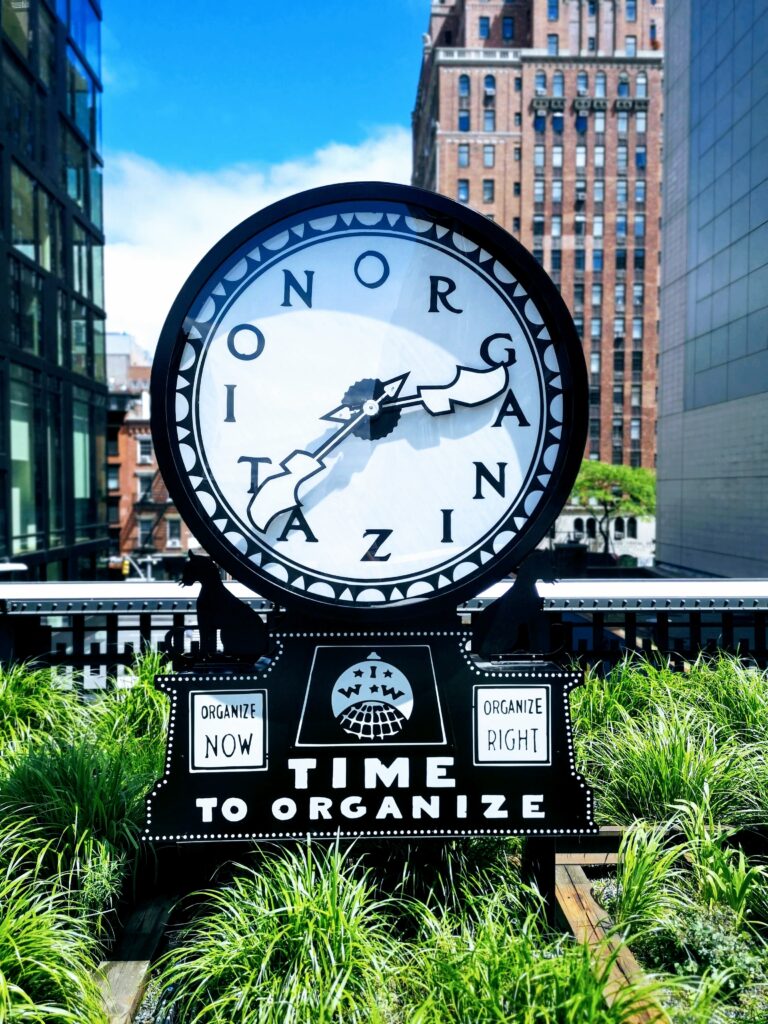
Administrative Tasks
To simplify your RFP process, begin by checking if your organization already has an appropriate digital asset management system in place or conduct a discovery process (as detailed in the section below). Secure written approval, establish a budget, put together a timeline, and consult with your procurement department to review RFPs and purchasing regulations.
The timeline should cover all essential phases, including RFP creation, distribution, vendor demonstrations, evaluation, and the often-lengthy procurement phase. Practical considerations such as staff vacations and holidays should also be accounted for to mitigate potential disruptions. By addressing these elements, the timeline becomes a comprehensive and practical plan for the entire RFP and DAM selection process, reducing the risk of unforeseen delays.
Finally, consider hiring an experienced DAM sourcing consultant who can leverage their expertise and knowledge of the marketplace to match your organization with the most suitable system for your users.
Discovery
In the process of DAM selection, the discovery phase involves a comprehensive investigation of the organization’s digital asset management needs. This typically starts with in-depth discussions with stakeholders and decision-makers. These conversations help identify specific requirements, challenges, and objectives to manage digital assets.

The discovery process often includes a thorough examination of the organization’s current workflows, analysis of the volume and types of digital assets, and an evaluation of the existing systems and technology infrastructure. Data collection methods such as surveys and data analysis may also gather information on user expectations, content lifecycle, access requirements, metadata needs, user permissions, integration considerations, and long-term preservation strategies.
The active engagement of key stakeholders and thorough review of pertinent in-house documentation are pivotal aspects of the discovery process.
Following the completion of the discovery phase, you should be able to fine-tune the problem statement, establish measurable objectives, and rank your functional and non-functional requirements. At this stage, broaden your vendor research efforts by attending industry events such as Henry Stewart DAM, and by exploring resources like online vendor directories and seeking recommendations from peers and professional networks.
Once you have a feel for vendors, try to narrow down your vendor list to just a handful for the most effective evaluation. A shorter list makes managing internal resources easier, allowing for a meaningful comparison of proposals and identification of strengths and weaknesses. With well-structured discovery and vendor selection processes, your DAM journey is off to a promising start!
RFP Structure

If you have a procurement department, it is likely they have an RFP format you must follow. In that case, consider how you can fit the following information into the existing structure. For those organizations that do not have an internal RFP format, use the following structure:
Overview
This is the initial point of contact and sets the tone for the entire RFP. Start with a concise introduction to your organization, capturing its essence in just a few sentences. Next, provide a brief background on the DAM selection project, highlighting the driving factors and context behind the need for a DAM solution.
A well-crafted problem statement is vital to ensure that vendors understand the challenges you face and the specific pain points you aim to address. Clearly articulate your business objectives, outlining the goals and outcomes you hope to achieve through the implementation of the DAM.
The overview document should include key details such as the current number of digital assets, their size in terabytes (or gigabytes or petabytes), and the primary formats you work with. If possible, provide a growth estimate in percentages, e.g., year-by-year growth of 10%. These specifics will help vendors tailor their solutions to meet your unique needs.

The overview also serves as a guide to vendors on how to navigate the RFP process. Include a timeline with key dates such as the RFP issue date, the deadline for vendor questions, when your organization will respond to questions, when vendors are required to confirm their intent to submit proposals, and the proposal submission deadline. Also, mention the subsequent steps, such as the notification of selected offerors for potential demonstrations and presentations, and the final selection process.
Make sure to specify the preferred delivery format and method for proposals and the required deliverables. Additionally, provide an overview of the evaluation criteria and scoring process that will be used to assess the proposals.
Include relevant contact information for any inquiries, and consider including a glossary of terms specific to DAM and the RFP. Clarify aspects like incurred costs to vendors, retention of submitted documentation, external partnerships, market references, and the importance of confidentiality and non-disclosure agreements (NDA).

Requirements Spreadsheet
In the process of crafting your DAM RFP, it is essential to establish a well-organized structure for your requirements. To begin, let’s define some key terms.
Functional requirements refer to specific capabilities or features that the digital asset management system must possess to meet your organization’s needs. These requirements can be structured as user stories, framing them in the context of “As an X, I need to Y, so that Z,” to clearly define who needs the functionality, what they need, and why. These functional requirements are essentially the building blocks that shape how the DAM system will operate, focusing on the user experience and the desired outcomes.
On the other hand, nonfunctional or technical requirements relate to the broader technical aspects that the DAM system should meet. These may include performance, security, scalability, and other technical considerations that are essential for the system’s effective operation. Additionally, format requirements specify the primary file formats and expectations for managing digital assets within the DAM. These include image formats (.jpg), videos (.mp4), documents (.pdf), and other file formats (e.g., Adobe and Microsoft file formats). They outline how the digital asset management system should handle and support these formats.
For further clarity, identify stakeholders and categorize them into three main types: DAM Administrators, Content Creators, and End Users. Defining their roles and capabilities, and noting the number of each, is particularly valuable for vendors, especially those who charge based on the number of user seats.
This structured approach not only helps DAM vendors understand your needs, it enables them to provide comprehensive and customized responses to your RFP. A helpful tool for organizing this content is a simple spreadsheet with distinct tabs for each requirement category. This provides a clear distinction between functional, nonfunctional/technical, and format requirements.
Usage Scenarios
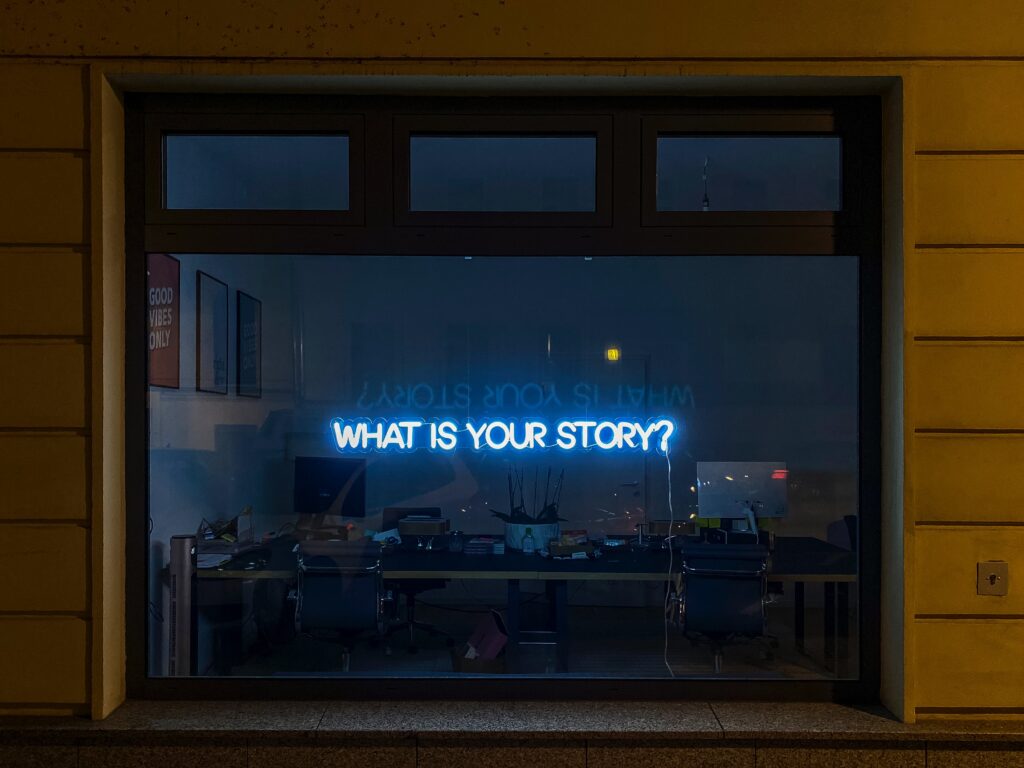
Usage scenarios are your secret weapon! They prioritize the user and bring your requirements to life.
A usage scenario, sometimes referred to as a “use case,” is a detailed narrative describing how a system or product is used in a specific real-world context. These scenarios provide a human-readable representation of functional requirements, offering a comprehensive view of how the system behaves and responds within different situations. Use cases help stakeholders and vendors, including both technical and non-technical individuals, to grasp how the system’s features and functionalities align with practical user needs and operational processes.
We highly recommend including three to seven usage scenarios in your RFP. If you have more, consider combining and prioritizing them. Each usage scenario should have a brief title, an objective that explains its purpose, and actors identified from your User Descriptions in the Requirements Spreadsheet. Provide background context and describe the main steps or interactions that actors will perform in the future system. Remember to allow flexibility for different solutions to the same problem. Usage scenarios are the heart of your RFP, so craft them to effectively convey your requirements.
Vendor Questionnaire
As you delve deeper into crafting your RFP, don’t overlook the significance of your vendor questionnaire. The vendor questionnaire is a comprehensive list of questions that go beyond requirements and use cases, focusing on higher-level aspects of the DAM vendor company, their implementation and support procedures, and proposal costs, providing valuable insights into their capabilities and suitability for the project.
The questionnaire serves as a vital component of your DAM RFP. It gathers in-depth information essential for the side-by-side evaluation of different systems. Number the questionnaire so that vendors can easily refer directly to the questions in their proposal.

A vendor questionnaire should cover general company information, product details, technical support, and references from comparable organizations. It should also include specific questions about the costs associated with the system, including license fees, implementation costs, and support expenses.
Conclusion
The Request for Proposal is a key component of the DAMS procurement process. RFPs provide structured and transparent frameworks for evaluating and selecting a new DAM system. They enable a fair and consistent evaluation process by clearly defining requirements and usage scenarios, evaluation criteria, and submission guidelines. This allows organizations to compare proposals from multiple DAM vendors objectively, ensuring that the selected vendor best aligns with their needs and objectives. RFPs help mitigate risks by providing a systematic approach to DAM vendor selection, fostering accountability, and minimizing subjective decision-making.
Are you ready to embark on your own DAM RFP process? We’ve got you covered! [Click here] to download our comprehensive DAM RFP checklists.
These valuable resources will guide you through planning, development, and distribution of your RFP, ensuring you achieve the best possible outcome. Don’t miss out on this essential tool to streamline your RFP journey.
Getting Started with AI for Digital Asset Management & Digital Collections
13 October 2023
Talk of artificial intelligence (AI), machine learning (ML), and large language models (LLMs) is everywhere these days. With the increasing availability and decreasing cost of high-performance AI technologies, you may be wondering how you could apply AI to your digital assets or digital collections to help enhance their discoverability and utility.
Maybe you work in a library and wonder whether AI could help catalog collections. Or you manage a large marketing DAM and wonder how AI could help tag your stock images for better discovery. Maybe you have started to dabble with AI tools, but aren’t sure how to evaluate their performance.
Or maybe you have no idea where to even begin.
In this post, we discuss what artificial intelligence can do for libraries, museums, archives, company DAMs, or any other organization with digital assets to manage, and how to assess and select tools that will meet your needs.

Examples of AI in Libraries and Digital Asset Management
Wherever you are in the process of learning about AI tools, you’re not alone. We’ve seen many organizations beginning to experiment with AI and machine learning to enrich their digital asset collections. We helped the Library of Congress explore ways of combining AI with crowdsourcing to extract structured data from the content of digitized historical documents. We also worked with Indiana University to develop an extensible platform for applying AI tools, like speech-to-text transcription, to audiovisual materials in order to improve discoverability.
What kinds of tasks can AI do with my digital assets?
Which AI methods work for digital assets or collections depends largely on the type of asset. Text-based, still image, audio, and video assets all have different techniques available to them. This section highlights the most popular machine learning-based methods for working with different types of digital material. This will help you determine which artificial intelligence tasks are relevant to your collections before diving deep into specific tools.
AI for processing text – Natural Language Processing
Most AI tools that work with text fall under the umbrella of Natural Language Processing (NLP). NLP encompasses many different tasks, including:
- Named-Entity Recognition (NER) – NER is the process of identifying significant categories of things (“entities”) named in text. Usually these categories include people, places, organizations, and dates, but might also include nationalities, monetary values, times, or other concepts. Libraries or digital asset management systems can use named-entity recognition to aid cataloging and search.
- Sentiment analysis – Sentiment analysis is the automatic determination of the emotional valence (“sentiment”) of text. For example, determining whether a product review is positive, negative, or neutral.
- Topic modeling – Topic modeling is a way of determining what general topic(s) the text is discussing. The primary topics are determined by clustering words related to the same subjects and observing their relative frequencies. Topic modeling can be used in DAM systems to determine tags for assets. It could also be used in library catalogs to determine subject headings.
- Machine translation – Machine translation is the automated translation of text from one language to another–think Google Translate!
- Language detection – Language detection is about determining what language or languages are present in a text.
AI for processing images and video – Computer Vision
Using AI for images and videos involves a subfield of artificial intelligence called Computer Vision. Many more tools are available for working with still images than with video. However, the methods used for images can often be adapted to work with video as well. AI tasks that are most useful for managing collections of digital image and video assets include:
- Image classification – Image classification applies labels to images based on their contents. For example, image classification tools will label a picture of a dog with “dog.”
- Object detection – Object detection goes one step further than image classification. It both locates and labels particular objects in an image. For example, a model trained to detect dogs could locate a dog in a photo full of other animals. Object detection is also sometimes referred to as image recognition.
- Face detection/face recognition – Face detection models can tell whether a human face is present in an image or not. Face recognition goes a step further and identifies whether the face is someone it knows.
- Optical Character Recognition (OCR) – OCR is the process of extracting machine-readable text from an image. Imagine the difference between having a Word document and a picture of a printed document–in the latter, you can’t copy/paste or edit the text. OCR turns pictures of text into digital text.
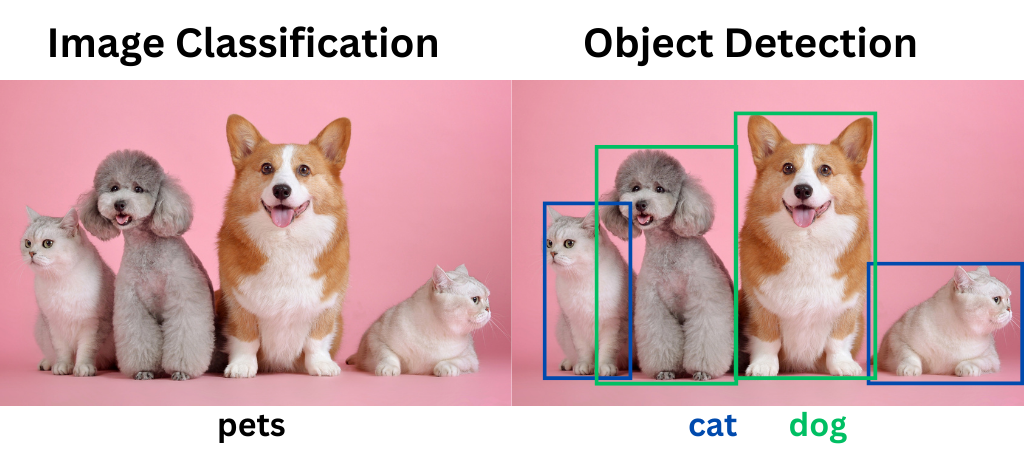
AI for processing audio – Machine Listening
AI tools for working with audio are much fewer and farther between. The time-based nature of audio, as opposed to more static images and text, makes working with audio a bit more difficult. But there are still methods available!
- Speech-to-text (STT) – Speech-to-text, also called automatic speech recognition, transcribes speech into text. STT is used in applications like automatic caption generation and dictation. Transcripts created with speech-to-text can be sent through text-based processing workflows (like sentiment analysis) for further enrichment.
- Music/speech detection – Speech, music, silence, applause, and other kinds of content detection can tell you which sounds occur at which timestamps in an audio clip.
- Speaker identification / diarization – Speaker identification or diarization is the process of identifying the unique speakers in a piece of audio. For example, in a clip of an interview, speaker diarization tools would identify the interviewer and the interviewee as speakers. It would also tell you where in the audio each speaks.

What is AI training, and do I need to do it?
Training is the process of “teaching” an algorithm how to perform its task.
Creating a trained machine learning model involves developing a set of training data, putting that data through a learning algorithm, and tweaking parameters until it produces desirable results.
You can think of training data as the “answer key” to a test you want the computer to take.
For example, if the task you want to perform is image classification–dividing images into different categories based on their contents–the training data will consist of images labeled with their appropriate category. During the training process, the computer examines that training data to determine what features are likely to be found in which categories, and subsequently uses that information to make guesses about the appropriate label for images it’s never seen before.
In addition to the labeled data given to the algorithm for learning, some data has to be held back to evaluate the performance of the model. This is sometimes called “ground truth” testing, which we’ll discuss more below.
Developing training and testing data is often the most time-consuming and labor-intensive part of working with machine learning tools. Getting accurate results often requires thousands of sample inputs, which may (depending on the starting state of your data) need to be manually processed by humans before they can be used for training.
Training AI tools sounds costly, is it always necessary?
Custom training may not be required in all cases. Many tools come with “pre-trained” models you can use. Before investing loads of resources into custom training, determine whether these out-of-the-box options meet your quality standards.
Keep in mind that all machine learning models are trained on some particular set of data.
The data used for training will impact which types of data the model is well-suited for—for example, a speech-to-text model trained on American English may struggle to accurately transcribe British English, and will be completely useless at transcribing French.
Researching the data used to train out-of-the-box models, and determining its similarity to your data can help set your expectations for the tool’s performance.
Choose the right AI tool for your use case

Before you embark on any AI project, it’s important to articulate the problem you want to solve and consider the users that this AI solution will serve. Clearly defining your purpose will help you assess the risks involved with the AI, help you measure the success of the tools you use, and help you determine the best way to present or make use of the results for your users in your access system.
All AI tools are trained on a limited set of content for a specific use case, which may or may not match your own. Even “general purpose” AI tools may not produce results at the right level of specificity for your purpose. Be cautious of accuracy benchmarks provided by AI services, especially if there is little information on the testing process.
The best way to determine if an AI tool will be a good fit for your use case is to test it yourself on your own digital collections.
How to evaluate AI tools
Ground truth testing is a standard method for testing AI tools. In ground truth testing, you create examples of the ideal AI output (ground truth) for samples of your content and check them against the actual output of the AI to measure the tool’s accuracy.
For instance, comparing the results of an object recognition tool against the list of objects you expect the tool to recognize in a sample of images in your digital asset management system can show you the strengths of the AI in correctly identifying objects in your assets (true positives) and its weaknesses in either not detecting objects it should have (false negatives) or misidentifying objects (false positives).
Common quantitative measures for ground truth testing include precision and recall, which can help you better calculate these risks of omission and misidentification. You can also examine these errors qualitatively to better understand the nature of the mistakes an AI tool might make with your content, so you can make informed decisions about what kind of quality control you may need to apply or if you want to use the tool at all.
Ground truth testing, however, can be costly to implement.
Creating ground truth samples is time-consuming, and the process of calculating comparison metrics requires specialized knowledge. It’s also important to keep in mind that ground truth can be subjective, depending on the type of tool—the results you’d expect to see may differ in granularity or terminology from the outputs the AI was trained to produce.
In the absence of ground truth, you can visually scan results for false positives and false negatives to get a sense of what kinds of errors an AI might make on your content and how they might impact your users.
Is it important that the AI finds all of the correct results? How dangerous are false positives to the user experience?
Seeing how AI results align with your answers to questions like these can help to quickly decide whether an AI tool is worth pursuing more seriously.
In addition to the quality of results, it is also important to consider other criteria when evaluating AI tools. What are the costs of the tool, both paid services and staff time needed to implement the tool and review or correct results? Will you need to train or fine-tune the AI to meet the needs of your use case? How will the AI integrate with your existing technical infrastructure?
To learn more about how you can evaluate AI tools for your digital assets with users in mind, check out AVP’s Human-Centered Evaluation Framework webinar, which includes a quick reference guide to these and many other questions to ask vendors or your implementation team.
When not to use artificial intelligence

With all of the potential for error, how can you decide if AI is really worth it? Articulating your goals and expectations for AI at the start of your explorations can help you assess the value of the AI tools you test.
Do you want AI to replace the work of humans or to enhance it by adding value that humans cannot or do not have the time to do? What is your threshold for error? Will a hybrid human and AI process be more efficient or help relieve the tedium for human workers? What are the costs of integrating AI into your existing workflows and are they outweighed by the benefits the AI will bring?
If your ground truth tests show that commercial AI tools are not quite accurate enough to be worth the trouble, consider testing again with the same data in 6 months or a year to see if the tools have improved. It’s also important to consider that tools may change in a way that erodes accuracy for your use case. For that reason, it’s a good idea to regularly test commercial AI tools against your baseline ground truth test scores to ensure that AI outputs continue to meet your standards.
Now what?
The topics we’ve covered in this post are only the beginning! Now that you’ve upped your AI literacy and have a basic handle on how AI might be useful for enhancing your digital assets or collections, start putting these ideas into action.
Learn how AVP can help with your AI selection or evaluation project
Preserving Digital Assets: A Gap in the DAM Marketplace
17 August 2023

Cultural heritage organizations increasingly seek out a digital asset management system (DAM) that integrates robust digital preservation capabilities for preserving digital assets. They often recognize the importance of investing in digital preservation but struggle with the challenge of maintaining separate DAM and digital preservation systems due to limited resources.
While DAM systems typically prioritize security, permissions, and utilize cloud storage—all found in digital preservation systems as well—they still lack the comprehensive functionality that cultural heritage organizations and others consistently seek to help with preserving digital assets.
Despite the maturity of the DAM market, there remains a persistent gap between the preservation functionality that cultural heritage organizations desire and the systems currently available.
At AVP, we have witnessed this shift in what organizations are seeking first-hand through our work assisting organizations in finding the perfect technology solutions to meet their unique requirements, from digital asset management and media asset management (MAM) to digital preservation systems and records management systems.
In light of this issue, I would like to delve into the reasons behind this disparity and share AVP’s recommendations on how organizations can navigate the technical landscape for preserving digital assets effectively. Let’s explore the evolving needs of organizations and uncover strategies for achieving their goals within the realm of digital asset management and digital preservation.
Why can’t Digital Asset Management just “do Digital Preservation”?
It is crucial to grasp the fundamental differences between these two types of systems and their respective functionalities.
According to IBM, a DAM is “a comprehensive solution that streamlines the storage, organization, management, retrieval, and distribution of an organization’s digital assets.”
The lending library
To paint a visual picture, envision a DAM as a lending library.

Just like books neatly arranged on shelves, digital assets are meticulously organized, described, and managed within the DAM. Library users can navigate the catalog using various criteria such as subject, author, or date to locate specific assets, just as they can in the DAM. And, similar to needing a library card to borrow books, access to the DAM requires registered users to have appropriate permissions to access and utilize the digital assets.
Essentially, a well-managed DAM ensures that your digital assets are securely stored, easily searchable, and readily accessible. It functions as a virtual library, providing efficient organization and control over your organization’s valuable digital resources.
The offsite storage
Building upon the library analogy, let’s delve into the unique characteristics of a digital preservation system.

Imagine the library books that are not frequently accessed. Instead of occupying valuable space on the main shelves, they are often relocated to a secure, climate-controlled warehouse. These books are packed in containers on tall shelving units, accessible to only a select few individuals. Browsing becomes nearly impossible, searching becomes challenging, and obtaining one of these books typically requires assistance from a librarian.
In the digital realm, a digital preservation system serves as the digital counterpart to this offsite storage. It replaces physical locked warehouses with secure user permissions, ensures file verification and fixity testing to maintain data integrity, employs packaging mechanisms called “bags,” and utilizes cold data storage for long-term preservation.

While a digital preservation system focuses primarily on safeguarding and preserving digital assets, it also prioritizes security and protection over immediate accessibility.
Same-same but different?
From these descriptions, it is evident that the fundamental purposes of DAM and digital preservation systems are significantly different, although there are areas of overlap. For instance, both the library and warehouse prioritize secure storage of their respective materials. (Ever walked out of a library without checking out your book only to set the alarm off?)
Likewise, both DAM and digital preservation systems maintain strong user permissions to ensure security. Similarly, while libraries may employ climate control measures — albeit less stringent than those governing the warehouse’s temperature and humidity levels — some DAMs may also implement “lightweight” functionality for preserving digital assets, such as fixity testing upon upload.
This distinction emphasizes the intrinsically divergent purposes of DAM and digital preservation system.
DAMs primarily excel in efficient asset management and user accessibility, allowing organizations to easily organize, retrieve, and distribute their digital assets. On the other hand, digital preservation system places paramount importance on long-term preservation and data integrity, safeguarding valuable assets for future generations.
How can I use a DAM system for preserving digital assets today?
Increasingly, DAM vendors are adding digital preservation functionality to their systems. At a minimum, most DAM systems perform:
- Checksum hash values (e.g., MD5) creation on ingest
- Event logging (whenever an action is taken on a file)
Some DAM systems can also do the following:
- Virus checking on ingest
- Hybrid (tiered) storage (a combination of hot and cold storage or online, nearline, and offline storage)
Only a very small number of DAM systems may also:
- Make checksum values visible to users
- Test existing checksum values on ingest
- Enable manual and/or regular fixity testing
- Run reports on or export event logs
And at the time of writing, no DAM performs automated obsolescence monitoring of file formats (to our knowledge).
With this in mind, the question to consider is: what’s good enough when it comes to digital preservation functionality in DAMS?
“Good enough” digital preservation
The concept of “Good enough” digital preservation has been circulating since at least 2014, thanks to groups like Digital POWRR. Essentially, it recognizes that not everyone can achieve or maintain the highest levels of digital preservation, such those defined by level four of the NDSA Levels of Digital Preservation or full conformance with ISO 16363 (Audit and certification of trustworthy digital repositories), for all digital assets (for all eternity).
For many, these guidelines can feel overwhelming and unattainable. When organizations search for a DAM solution, they often have an expectation that it will solve all digital preservation planning challenges and result in a perfect A+ in digital preservation. However, as we have come to realize, this expectation is not in line with reality.
So, what should you do?
Let’s dive into some ideas on how we can tackle these issues.
Understand the difference between DAM system and Digital Preservation system functionality
First and foremost, organizations should focus on developing a clear understanding of the distinctions between a DAM and a digital preservation system. This knowledge forms the foundation for informed decision-making and empowers organizations to choose the right path.
Clarify your appetite for risk

Next, organizations need to assess their risk comfort levels. What functionalities are essential for their peace of mind? Are there specific data management or digital preservation regulations they must comply with? Can a DAM system meet these requirements effectively? If not, organizations must determine the functionalities that take precedence and decide whether a DAM or digital preservation system is more suitable for their needs.
DAM vendors play a crucial role in this process. It is essential for them to familiarize themselves with basic digital preservation software functionality. This understanding enables them to respond effectively to client requirements and deliver solutions that align with their specific needs.
Request standards compliance
DAM vendors should actively consider aligning with some guidelines from the NDSA Levels of Digital Preservation, for example. By doing so, vendors not only benefit clients with a need for digital preservation but also contribute to the long-term accessibility of assets within the DAM for all users. This alignment has the potential to promote industry-wide best practices and ensures the preservation and availability of digital assets beyond individual client needs.
However, it is essential to recognize that not all DAM systems need to encompass complete digital preservation functionality.
The reality is, some organizations heavily invested in digital preservation may have a particularly low risk tolerance for loss and, despite DAM’s other capabilities, may choose not to depend on it alone to achieve their preservation objectives.
Choosing a solution for preserving digital assets
In light of these considerations, it is crucial for organizations to engage in internal discussions to determine their specific needs and priorities. These conversations should address risk levels and the functionalities that are essential for their peace of mind and compliance with their data management requirements.
By having these dialogues, organizations can collectively define an acceptable level of preservation within the realm of DAM. Although reaching a consensus may present challenges, the goal is to find a comfortable middle ground that satisfies the needs of everyone in the organization. This process not only addresses their requirements effectively but also has the potential to drive innovation within the DAM industry as a whole.

If you are considering acquiring a DAM in the near future and have digital preservation requirements, we are excited to discuss the possibilities with you. AVP is here to assist you in exploring your options and finding the ideal system for your organization. We eagerly await the opportunity to assist you on this journey.
The Importance of Choosing the Right Digital Asset Management System
5 July 2023
As organizations grow and their workflows evolve, so does their need for the right technology. But identifying which tools will meet your needs now — and as your business scales — can be a major undertaking.
Investing in a digital asset management (DAM) solution is no different. While DAM systems are designed to simplify how digital content is organized and managed, selecting the right solution can actually be really complicated. After all, there are dozens of vendors to choose from, all with a unique combination of functionality, features, and services. On the flip side, being able to identify and prioritize your business requirements requires a lot of due diligence.

And unfortunately, if you select a solution that doesn’t meet your needs there are a range of significant consequences. Let’s take a look at the risks entailed in making the wrong- DAM software investment — and how to avoid them.
The Risks of Getting it Wrong
Unwanted Expenses
By the time you realize that you’ve selected a a digital asset management solution or system that won’t support your use cases as expected, you will likely be deep into software implementation. This includes configuration, content migration, piloting, and possibly even the beginning of system launch. Many stakeholders will have committed significant time to this initiative.
At this point, it is pretty hard to cut your losses and change course. Not only will there be the hard costs of ending the current contract — but there will be further hefty staffing expenses. Scrapping plan A means starting from scratch with another procurement process and then spending months configuring, migrating, and preparing for roll out — a second time. We all know that time means money, and this redundant work will be costly.
It is not easy to let go of those sunk costs, so most likely, you will continue to persevere. You may not be able to tell the difference between poor implementation, and the wrong system. Either way the challenges will continue to grow in significance and complexity.

Broken Trust
While the technical part of a software launch can be complicated, with numerous timelines and milestones, getting people to embrace the new system can be even more challenging. After all, change is hard — even when it’s for the better. And when the solution doesn’t meet expectations, you risk damaging the trust between you and your stakeholders.
And once this trust is broken, it is difficult to repair. Stakeholders that feel burned or frustrated may not be interested in engaging in the process again, which can have a chilling effect on system adoption and even create a self-fulfilling prophecy that the project is doomed to failure.

Lost Opportunity
In addition to unwanted staffing expenses and damaged trust, investing in the wrong digital asset management system will delay your time to value. In other words, it extends the time needed to realize all of the gains that you were hoping for when you invested in a digital asset management system.
While delays and pivots play out, all of the original challenges that were drivers for making this technology investment continue to grow, such as workflow efficiencies, poor user experience, brand inconsistencies, and general content chaos. For organizations that manage archival assets, every month can bring the permanent loss of materials due to decay or obsolescence.
Not choosing the right DAM system means that these challenges continue to balloon — greatly prolonging the time until you realize DAM ROI.

Project Viability
A final risk inherent in choosing the wrong digital asset management system is the possibility that it sinks the project entirely. The decision to implement a new DAM system is often part of a larger technology strategy endorsed by executive leadership. And if the initial selection is a failure, it can create waves that cast doubt on the value of the investment.
This loss of confidence can threaten the existence of the entire DAM project — putting careers at risk and leaving a legacy that is difficult to overcome.

How to Choose the Right Digital Asset Management System, the First Time
Clearly, with any major technology investment the stakes are high. And righting the ship after a wrong decision entails considerable work and expense.
That’s why many organizations wondering how to choose a digital asset management system turn to a DAM consultant to guide their selection process. Including a consultant on your team can add clarity and efficiency at every stage of the process and sets the project up for success: from identifying specification requirements and drafting a request for proposal (RFP) all the way through vendor evaluation.
In addition to avoiding the risks outlined above, the benefits of working with a top digital asset management systems consultant include:
- Confidence that you’ve uncovered, defined, and prioritized all of your content workflow and business needs
- The ability to articulate these needs to avoid disconnects or miscommunications with your vendor, down the road
- Access to a data-driven, systematic approach that allows for informed and clear decisions, based on the right criteria
In many ways, working with a digital asset management consultant is like an insurance policy against going down the wrong path — allowing you to minimize your risk and maximize your reward.

AVP’s Approach to DAM Selection
At AVP, we offer DAM selection services that can be tailored to the needs of every organization. DAM is anything but a one-size-fits all investment, and our people-first approach allows us to provide the right level of support, every time.
AVP Select services are organized into two options:
- Full Service Technology Consulting (aka Managed Select): We offer three bundles of consulting services that all begin with a stakeholder alignment workshop. From there, you can decide how long you’d like us to lead the process.
- Technology Selection Training (aka Self Select): Our training option often appeals to customers who have the right team assembled but could benefit from step-by-step guidance on how to choose a digital asset management system.
All of our DAM consulting services are rooted in a proven technology selection process that has helped our customers make the correct DAM investment, with confidence.
Make the Best DAM Decision, with AVP
With support from AVP’s digital asset management consultants, you can begin your DAM journey on the path to success.
We’d love to learn about your unique content workflows and technology needs. Contact us to learn more about AVP Select — and how we can work together to achieve your DAM goals, faster.
Finding the Right DAM AI Tools: AVP’s Human-Centered Evaluation Framework
23 March 2022
Henry Stewart DAM Webinars 2022
Watch the webinar with a searchable transcript and embedded closed captions here.
[Read more]Scenario Planning For A Successful DAM Journey
10 January 2020
Getting to Success: A Scenario-driven Approach for Selecting, Implementing, and Deploying Digital Asset Management Systems
Usage scenarios are simple narrative descriptions of current or future state use of a system. For DAMS initiatives, scenarios are an important tool that can be used throughout all stages: selection, implementation, launch, and beyond. Scenarios are a lightweight, simple, clear, and effective method for defining the goals and intended use of a system. They help facilitate communication between stakeholders and vendors, providing a starting point for ongoing conversation that ensures all parties have equal footing in the discussion. This paper provides a definition of scenarios, describes their key features and structure, identifies their benefits, and offers recommended practice for using scenarios throughout the lifecycle of a DAM deployment process.
This paper was originally published in the Journal of Digital Media Management, Volume 7 (2018-19).
Introduction
Organizations embark on digital asset management selection and implementation efforts for a number of reasons: to create a centralized library of assets, to enable efficient collaboration between departments, to improve review and approval processes, to streamline multi- or omni-channel distribution, and more. In all cases, the end goal is undoubtedly the same: to successfully transform some aspect of how the organization works, and to affect meaningful and productive change that will ultimately allow the organization to better serve its mission and stakeholders.
When the need for change and the opportunity for improvement is first identified, agreed upon by the relevant stakeholders, and given the green light by senior leadership, the possibilities are exciting. But it is well known that organizational change efforts can be long and difficult. Statistics and stories abound on the high failure rate of technology projects.1 Categorically speaking, digital asset management is no exception. Selecting the right technology is a daunting task. Implementation is yet a further hurdle. Things can get even more difficult at the launch and roll-out stages. Reaching the end goal can take years of sustained effort. This is not to say that embarking on technological change is not a good idea, or that it shouldn’t be undertaken. Rather, acknowledging the inevitable challenges, and identifying ways of mitigating them, should be an important aspect of planning.
Undoubtedly, one of the key challenges throughout digital asset management system (DAMS) selection and implementation process is clearly defining the system goals, getting agreement on these goals from all internal stakeholders, and ensuring that those goals are well understood by the system developer or vendor. This challenge persists throughout all phases of the project, as goals evolve through different stages. Author Mike Cohn describes software development (or, as is being discussed in this paper, procurement and implementation) as a communication challenge between the technologists who build the software, and the business or customers that will use it. Cohn notes that communication between these groups is fraught with potential for error, stating: “If either side dominates these conversations, the project loses.”2 Because these groups approach the work from such different backgrounds and perceptions, it can seem as if they are speaking different languages.
However, there are tools and methods that can be used to help manage the change process, level set the conversation to a shared understanding and common set of terminology, and ensure strong communication between all involved parties. For technology efforts like digital asset management implementations, usage scenarios (hereafter, scenarios”) are one of those tools. Usage scenarios put the user front and center, a reminder that the technology is being implemented to serve people and help them achieve specific goals. Scenarios are created by the business, and used as a starting point for conversation around stakeholder needs and goals with technologists. Scenarios describe a situation in which one or more users would execute a task or set of tasks using a system. They ground the conversation in a consistent and easily understood format, providing a starting point for ongoing communication and action, helping ensure that no one side will dominate. And, importantly, scenarios keep the why of the project at the front and center, a question which will be continually revisited throughout.
This paper explores a few ways that scenarios can be used throughout the DAMS selection, implementation, and deployment process. It argues that a set of scenarios that are agreed upon by all key stakeholders provide a meaningful testbed of information that can serve as a tool for ensuring consistency, transparency, and measurability, connecting all phases of the technology implementation lifecycle. While this paper is written with the perspective of the DAMS manager/owner in mind, system vendors may also find these recommendations useful to incorporate into the client onboarding process.
Defining Scenarios
Usage scenarios are narrative descriptions of interactions between one or more users and the system. Most importantly, scenarios are stories. Advocates Mary Beth Rosson and John M. Carroll note that scenarios, “consist of a setting, or situation state, one or more actors with personal motivations, knowledge, and capabilities, and various tools and objects that the actors encounter and manipulate. The scenario describes a sequence of actions and events that lead to an outcome.”3
The idea of using scenarios in system design gained strong support in the early 1990s. Finding that using requirements alone defined a limited view of the system, and most importantly, lacked the human component, engineers began to explore the use of scenarios as a technique to compliment the requirements development effort. As human-computer interaction emerged as a critical area of research and development, numerous papers, books, and tutorials were contributed to the growing volume of literature on this topic. Scenario-based design and development is also closely aligned to the human-centered design process, or design thinking, which is an approach to creative problem solving that focuses on understanding human needs first.
Scenarios are attractive and widely used in technology development and deployment projects for a number of reasons, perhaps most importantly because of their simplicity. Requirements engineering author and thought leader Ian Alexander notes that, “Scenarios are a powerful antidote to the complexity of systems and analysis. Telling stories about systems helps ensure that people—stakeholders—share a sufficiently wide view to avoid missing vital aspects of problems.” He adds, “Scenarios are applicable to systems of all types, and may be used at any stage of the development life cycle for different purposes.”4
Scenarios describe expected every day use of the system, and can be created from different viewpoints to serve different functions. Two of these views that will be explored in this paper are defined by researcher Alistair Sutcliffe:
- “a story or example of events as a grounded narrative taken from real world experience,” and,
- “a future vision of a designed system with sequences of behaviour and possible contextual description.”5
The future-facing scenario perspective will be most useful during selection, implementation, and launch phases of a DAMS initiative, with a shift to current state scenarios during and following launch.
Creating Scenarios
Scenarios are fairly simple and quick to create. They don’t require specialized knowledge or expertise to develop, although following a few best practices will result in more effective scenarios. Their greatest strength is that they are easy to understand and thus it is easy for the stakeholders they represent to provide feedback on them.
When drafting scenarios for DAMS projects, authors should considering including, at minimum:
- Unique Identifier for each scenario
- Title/simple description
- List of participating actors (archetypal personas based on the organization’s users and roles)
- Narrative description (1-4 paragraphs)
- Expected outcome or success criteria (the things that must be true for the scenario to be accepted by stakeholders once implemented)
Below is a simple example:
| 01 Asset Reuse for Marketing Campaign |
| Actors |
| Marketing Associate; Intellectual Property Associate |
| Scenario |
| A Marketing Associate (MA) needs photos for an upcoming campaign. The MA searches in the DAMS, first by keyword, then using facets to narrow results to images only. She identifies a selection of potential images, and puts 20 images into a lightbox for review. MA shares the lightbox with an Intellectual Property Associate (IPA) directly via the DAMS. The IPA receives an email with a link to the lightbox, asking her to review and approve. The IPA approves 12 of the images and denies use of 8. The IPA indicates in the comments that the branding needs to be updated on 2 of the approved images. The system alerts the MA which of the images have been approved. She downloads the images as a batch in the format and size she needs. The system tracks, at an asset level, all interactions and approvals. |
| Success Criteria |
| Users can search by keyword and refine using facetsUsers receive email notifications when assets are shared via lightboxes (or similar)Assets can be routed to system users for approvalUsers can clearly approve or deny assets for useSystem allows for users to leave comments visible to other users with appropriate permissionUsers can specify asset download format and resolutionAssets can be downloaded as a batchThe system tracks approval and usage for later reporting |
Effective scenarios should:
- Follow the 80/20 rule: At minimum, be sure to capture cases that represent 80% of the institution’s anticipated use of the system. However, don’t entirely neglect the edge cases—some of these may prove critical later on.
- Be constrained to a specific situational goal and outcome: If a scenario is becoming to long and includes multiple end state goals, consider breaking it into multiple scenarios. However, if you need to describe alternatives, these can be added as an additional component to the original scenario. For example if a scenario describes a checksum validation process, include the successful outcome in the main narrative description (e.g., all files pass), and create an alternative path for the case when there is a failure (e.g., one file does not validate).
- Not be prescriptive: In their book, The Right Way to Select Technology, authors Tony Byrne and Jarrod Gingras note that when writing scenarios for the purpose of technology selection, “You want to leave it open-ended enough so that the vendor can do the prescribing of how their solution best meets your needs. So, in your stories, talk about what employees and customers do, but don’t go into too much detail about how they do it.”6
- Not include subjective or personal preferences: Statements such as, “the user finds the interface intuitive” are not easily measurable as each user will have a different interpretation of “intuitive.”
- Be demonstrable and testable: A vendor should be able to show you how their tool solves the scenario and/or the users should be able to complete the described tasks themselves during testing (see Implementation, below).
- Strive to remove assumption and internal biases: It may help to enlist an objective third-party to help create scenarios, or provide feedback on existing drafts. Internal stakeholders are more likely make assumptions—such as using terminology that holds an agreed upon meaning within the institution, but may be interpreted differently by others—that an external party would not.
Selection
In his paper “Scenario-based Requirements Engineering,” Sutcliffe states: “Scenarios are arguably the starting point for all modelling and design, and contribute to several parts of the design process.”7 System selection and/or development is a typical starting point for scenario creation. At this stage, scenarios serve several primary functions.
First, scenarios create agreement and buy-in amongst stakeholders about how the future system should work. Before a DAMS RFX is issued, a team should spend considerable effort defining and documenting what they would like the system to enable at their organization, and goals for how they would like the system to work. This documentation will take several forms, including business requirements (why the system is desired), functional requirements (what the system should do, at a granular level), and non-functional requirements or constraints (including technical and hosting requirements, performance requirements, format and other data requirements, etc.). Scenarios accompany these to round out a set of requirements.
At this stage, it is especially important that this process is inclusive of all key stakeholders—in the experience of this author, some DAM failures can be traced to the requirements process not involving the right people, and important needs not being considered during selection. By participating in the scenario development process, stakeholders are given the unique opportunity to think creatively about how they want to be able to work in the future, and what those improvements will look like compared with their current situation. This also helps people feel invested in the system selection process, and will help them see themselves as users of candidate systems that are demonstrated, which will result in more meaningful input during the final decision process.
For an RFX, typically around 6-12 scenarios will be created. Each scenario should describe a typical use of the system. When sketching out ideas for scenarios, it is not uncommon to find multiple ideas that ultimately illustrate the same set of functionality, with a few slightly different parameters (e.g., organizing assets from an event, organizing assets for a project). In these cases, only one scenario that captures this set of goals needs to be created. For the benefit of stakeholders who may become disappointed or frustrated if their needs are not explicitly reflected, the scenario may include a section listing “also applicable to” workflows.
Scenarios created for the purpose of DAMS selection should reflect future state, and paint a picture of what the organization expects the system will enable once it is launched. This author has helped numerous organizations draft scenarios for DAMS, and finds that often stakeholders struggle with two aspects of this process: 1) shifting their thinking to the future, rather than current, state, and 2) committing to scenarios when the workflows haven’t been finalized yet. Stakeholders will often need coaching and multiple rounds of feedback to help them overcome the first hurdle. For the second, it is important to remember that at this stage, scenarios don’t need to align perfectly to future workflows. These will not have been defined yet, and if they have, they will undoubtedly be tweaked following the implementation of new technology.
The second function of scenarios at this stage is that they illustrate for software vendors/developers how the system will be used. Scenarios allow vendors to better understand the institution and the goals of the RFX, and to craft more tailored responses. Scenarios give a sense of the different actors, and their roles and motivations. They bring to life specific individual requirements and tie them to real-world usage. When reviewing an RFP with a list of business, functional, and non-functional requirements, vendors can only gain a certain degree of understanding of how an organization will use the system. By adding a set of scenarios, those requirements come to life.
Scenarios can also become an important part of the vendor’s proposal. By including a scenario worksheet, and asking vendors to describe how their system would fulfill each scenario, an organization can not only learn more detail about how each system works, but can also get a sense of how well the vendor understands their needs and goals through their response. Vendors can be asked to include additional information including preconditions (configuration, customization, or other set up that must be in place before the scenario can be fulfilled) and an estimated timeline for implementation so that this scenario can be tested by users. This information helps reveal which systems are more readily able to support the organization’s needs out of the box, and which will require (potentially costly) customization. These responses can become an important criteria amongst others (budget, requirements alignment) that are used to narrow down a field of candidates to 2-3 that can be invited for demonstration.
The previous scenario example can be transformed into a vendor response table as follows (blue shaded cells to be completed by respondents):
| 01 Asset Reuse for Marketing Campaign |
| Actors |
| Marketing AssociateIntellectual Property Associate |
| Scenario |
| A Marketing Associate (MA) needs photos for an upcoming campaign. The MA searches in the DAMS, first by keyword, then using facets to narrow results to images only. She identifies a selection of potential images, and puts 20 images into a lightbox for review. MA shares the lightbox with an Intellectual Property Associate (IPA) directly via the DAMS. The IPA receives an email with a link to the lightbox, asking her to review and approve. The IPA approves 12 of the images and denies use of 8. The IPA indicates in the comments that the branding needs to be updated on 2 of the approved images. The system alerts the MA which of the images have been approved. She downloads the images as a batch in the format and size she needs. The system tracks, at an asset level, all interactions and approvals. |
| Success Criteria |
| Users can search by keyword and refine using facetsUsers receive email notifications when assets are shared via lightboxes (or similar)Assets can be routed to system users for approvalUsers can clearly approve or deny assets for useSystem allows for users to leave comments visible to other users with appropriate permissionUsers can specify asset download format and resolutionAssets can be downloaded as a batchThe system tracks approval and usage for later reporting |
| Solution Description |
| Response: |
| System Preconditions |
| Response: |
| Estimated Implementation Timeline |
| Response: |
| Additional Documentation |
Finally, scenarios provide a testbed of material for system demonstrations, enabling an apples-to-apples comparison of how different systems would fulfill each situation. Once the candidate pool is reduced to a handful of top systems, asking all of these vendors to demonstrate the same subset of scenarios (typically 3-5) and using assets and metadata provided by the organization enables stakeholders to get a real sense of how the system will work. In contrast to a standard demo, which the vendors have rehearsed time and again and are designed to show the best of the system, scenario demonstrations can reveal flaws and aspects of the site that are less streamlined. In other words, they help demonstrate how it really works for the specific users.
Implementation
Scenarios can play a vital role during the implementation process by providing a foundation for further refinement of requirements and definition of completeness for launch phases. One way to approach DAMS implementation is to use an Agile framework. As noted by the Agile Alliance, Agile is simply, “the ability to create and respond to change.”8 Agile emerged as an approach to building software so that inevitable changes in focus and priority could be easily managed. Frameworks such as Scrum, which emphasizes cross-functional project teams and consistent development cycles known as “sprints”, have been applied to other contexts outside of software development. Agile is an ideal fit for DAMS implementation, given the number of stakeholders and unknowns, and the need for clear structure and communication.
Scenarios provide an excellent starting point for the development of user stories, a human-centered communication tool from the Agile community, which describes individual system features from the perspective of a user. Once a DAMS has been selected, the original scenarios should be revisited. During the time between system selection and the engagement with a DAMS vendor or developer, additional needs may arise. Scenarios provided in the original RFX likely need to be updated, refined, or expanded. Additional scenarios may need to be added.
Following the revision process, a set of agreed upon implementation scenarios will be available. These can also be deconstructed into discrete individual user stories, which take the format:
As a _[actor]_ I want _[goal/desire]_ so that _[benefit]_.
User stories can be written for each functional aspect of the system that is described in a given scenario, ensuring that all success criteria are met. User stories can be accompanied by acceptance criteria, which are conditions that must be satisfied in order for the product to work as intended by stakeholders.
For example, given the previous scenario example, a number of user stories and acceptance criteria can be derived. Two examples might be:
| Story | Acceptance Criteria |
| As a Marketing Associate, I want to be able to share a collection or lightbox of selected assets with another user so that I can request approval for use in a campaign | User 1 can create a lightbox and share with another userBoth users can access the same collection/lightbox |
| As a Marketing Associate, I want to be notified once assets I have selected are approved, so that I know when they are ready to download. | User 1 routes a selection of images to User 2 for approvalUser 2 indicates approval of selection within the systemSystem sends email notification to User 1 |
These can be categorized according to type (e.g., search, metadata, integration), and can be prioritized according to their importance for the relevant stakeholders. The user stories can then be delivered to the system vendor, along with the scenarios, for initial setup and configuration of the system, and/or to internal stakeholders responsible for additional configuration.
Once a set of initial user stories are created, two testbeds of material will now be available:
- User stories, which can be tested and validated individually, according to provided acceptance criteria
- Usage scenarios, which can be tested and validated by the identified actors to ensure that the entire workflow can be completed, according to the provided success criteria
The user stories derived from implementation scenarios will not reflect all the requirements that users have for the system, but it will provide an initial set of stories that are rooted in the original scenario, which will become useful as the launch phase approaches. As implementation proceeds, and new needs arise, new requirements can continue to be created in user story form.
Getting to Launch
A scenario-driven approach to DAMS selection and implementation enables what can be termed test driven deployment. This concept is borrowed from test driven development, an approach to iterative software development that relies on writing tests first, then writing code to reach a minimum level of functionality required to pass those tests. In test driven deployment, scenarios and user stories are tests in and of themselves, and thus become an ongoing component of implementation and launch phases of DAMS deployment. Throughout implementation (and beyond), the scenarios and user stories will become important tools for testing, providing feedback, and measuring progress toward launch goals. Again, this process will naturally fit into an Agile framework.
It is important to establish a clear scope for an initial launch candidate. This scope should include definition of the user stories that must be completed and validated. Bear in mind that users needs will continue to evolve and grow, so keeping a backlog of stories to be prioritized and addressed over time is critical. However, communicating the goal of incremental deployment, and maintaining a transparent user story backlog will help manage user expectations and avoid scope creep.
Acceptance of the initial launch candidate will require completion and validation of all user stories prioritized for this milestone. Prior to engagement of end user groups, all user stories should be tested and validated by the DAMS owner/manager, then by key stakeholders. This exercise will likely result in discovery of bugs, incomplete stories, as well as some additional user stories that need to be implemented prior to full acceptance, and should be communicated back to the vendor. Maintaining use of the user story format will ensure consistency in communication throughout this back and forth process.
As launch approaches, teams will begin testing and training within the system. One useful test is to ask these groups to walk through the relevant narrative scenarios and success criteria, working through the outlined steps within the system, and determine if they are sufficient for launch. While additional user acceptance testing may be performed as well, scenario tests are important for tying deployment back to original requirements that stakeholders are already familiar with.
This entire cycle can continue as additional teams are brought on to the system. New teams who weren’t engaged in the initial selection and implementation stages should go through the same process, starting with the development of scenarios, followed by the create of prioritized user stories. Scenarios can also be used to craft meaningful and easy-to-digest training materials, and used as part of training sessions. Providing new users with example situations help make the system more relatable.
Ongoing Improvement
Scenarios can also play an important role over time to create system improvements. For system enhancements, scenarios can be used to communicate the future state goal, and the changes that might be required to reach that state. For bugs or other issues, scenarios can be used to describe the user’s experience when they perform a given task, or what happens when things are not working as expected. In this case, the framing of the scenario should shift from future state (as has been suggested throughout this paper) to current state, which is the other type of scenario defined by Sutcliffe: “A story or example of events as a grounded narrative taken from real world experience.”9 The scenarios created at this stage could be termed what Sutcliffe refers to as “problem statement scenarios.”
Furthermore, ongoing user testing should also be an important part of a DAM program, so that the product owners can understand how users are working in the system, and what improvements could make their experience better. Scenarios provide an excellent starting point for the creation of task-oriented user tests, which can be delivered to participants in moderated or unmoderated sessions.
Conclusion
Scenarios are not a panacea and certainly not the only tool in your toolbox. However, consistent use of this format can facilitate clear communication between all parties involved in the DAMS selection, implementation, and management process. All technology projects run the risk of failure at worst, and transforming how the organization works at best. Communication is one of several critical factors that will contribute to the outcome.
Scenarios help communicate the project vision. They can support stakeholder engagement and buy-in. They enable traceability of system features to original requirements. They support testing. The simplicity and clarity of scenarios and user stories make them excellent documentation and training resources.
One important advantage of scenarios is that they are extremely lightweight. DAMS initiatives inevitably result in a great deal of documentation, and readers may feel a reluctance to add more. However, the experience of this author is that a set of key scenarios—just a few short paragraphs each—has the potential to make the selection, implementation, and launch processes streamlined and understandable to all stakeholders. As Byrne and Gingras emphasize in The Right Way to Select Technology, “After defining the business case, [scenario creation] is the most important foundational work you will do, so spend time to get it right.”10
References
1. Marr, Bernard, ‘Are these the 7 reasons why tech projects fail? Forbes; September 13, 2016.
2. Cohn, Mike. User Stories Applied. Addison-Wesley Professional; 2004. Page 3.
3. Carroll, John M., Rosson, Mary Beth. Scenario-Based Design. In Jacko, J., Sears A., editors. The Human-Computer Interaction Handbook: Fundamentals, Evolving Technologies and Emerging Applications. Lawrence Erlbaum Associates; 2002.
4. Alexander, Ian, Maiden, Neil. Scenarios, Stories, Use Cases: Through the Systems Development Life-Cycle. 1st Edition. Wiley; 2004. Page 3
5. Sutcliffe, A. (2004) ‘Scenario-based requirements engineering’, in Proceedings of the 11th IEEE International Requirements Engineering Conference, Monterey Bay, CA, 12th September, pp. 320–329.
6. Byrne, Tony and Gingras, Jarrod. The Right Way to Select Technology. New York: Rosenfeld Media; 2017. Page 43.
7 Sutcliffe, ref 5 above
8. Agile Alliance. (n.d.) ‘Agile 101’,(accessed 9th April, 2019).
9. Sutcliffe, ref 5 above
10. Byrne and Gingras, ref 5 above.
AVP’s Digital Asset Management for Museums & Cultural Heritage
21 January 2022
AVP is an information innovation firm.
We bring a cross-disciplinary team of experts to help organizations transform how they protect, manage, and use data and digital assets. AVP’s expert team has over 15 years of experience designing holistic, user-based solutions to protect and deliver cultural heritage content to key audiences. We work alongside you to create impactful digital asset management solutions tailored to your organization and empower you to grow and sustain them.
AVP Digital Asset Management Services Map for Museums & Cultural Heritage
Plan
- Digital Asset Management Strategy
- Roadmapping
- Resource Planning & Advocacy
Launch
- Implementation Planning
- System Configuration
- Digital Asset Security
- User Testing
Pilot
- UX Research & Design
- Machine Learning/AI
- MVP Development
Breakthrough Workshops
- Lightning Decision Jam
- Creating a Guiding Vision
- Data Selection & Prioritization
- Search, Browse, and Discovery
Build
- Custom Software Solutions
- Workflow Automation
Connect
- Data Migration
- System Integration
Key
- Plan
- Select
- Launch
- Build
- Pilot
- Connect

Who We Work With
We have been honored to partner with some amazing museums and cultural heritage organizations:
- Smithsonian Institution
- Museum of Modern Art (MoMA)
- Library of Congress
- National Museum of American History
- National Gallery of Art
- The Frick Collection
- John F. Kennedy Presidential Library Foundation (Library & Museum)
- United Nations
- United States Holocaust Memorial Museum
- Wisconsin Veterans Museum
- Rock and Roll Hall of Fame
- Country Music Hall of fame
- The Huntington
Each client had distinct goals and objectives and a unique mix of people, assets, budgets, systems, policies, and workflows. AVP’s cross-disciplinary team of digital asset management experts helped chart a path to success and deliver impactful results using a combination of the following services:
- AVPPlan to define a path toward successful outcomes through effective and sustainable asset management
- AVPSelect to narrow down which technologies best fit client requirements, use cases, and budget
- AVPActivate to launch, build, grow and expand an organization’s digital asset management program
- AVPExplore to prototype, test, and deploy different concepts to bring your ideas to life
Smithsonian Institution: Preserving the Nation’s Past, Preparing for the Future
AVP has had the pleasure of working with the Smithsonian Institution on a few occasions to deliver:
- A comprehensive look at the current state of preservation operations
- Analyzed risks and gaps
- Top challenges and corresponding recommendations
- Policy improvements to support digital preservation
Our deliverable included eight overarching phases to ensure the Smithsonian’s valuable digital content persists far into the future.
What Our Clients Are Saying
“They are highly knowledgeable, are experienced working with museums and cultural institutions, extremely professional and focused.”
National Museum Client
“What sets your team apart is the way you combine top subject matter expertise with great listening and communication skills.”
Public University Client
“I most appreciated the initiative, flexibility, as well as the creativity they were willing to provide during this process…I was most impressed by the high quality of customer service provided.”
Private University Client
“…People were pleasantly surprised about the clarity of the report and presentation, particularly on a topic that is historically dry and goes over people’s heads.”
National Museum Client
“Highly intelligent, professional approach to assessing our needs and very reliable timetable, budget adherence and super deliverables.”
National Museum Client
“They have a strong work ethic and are very responsive to customer needs.”
National Museum Client
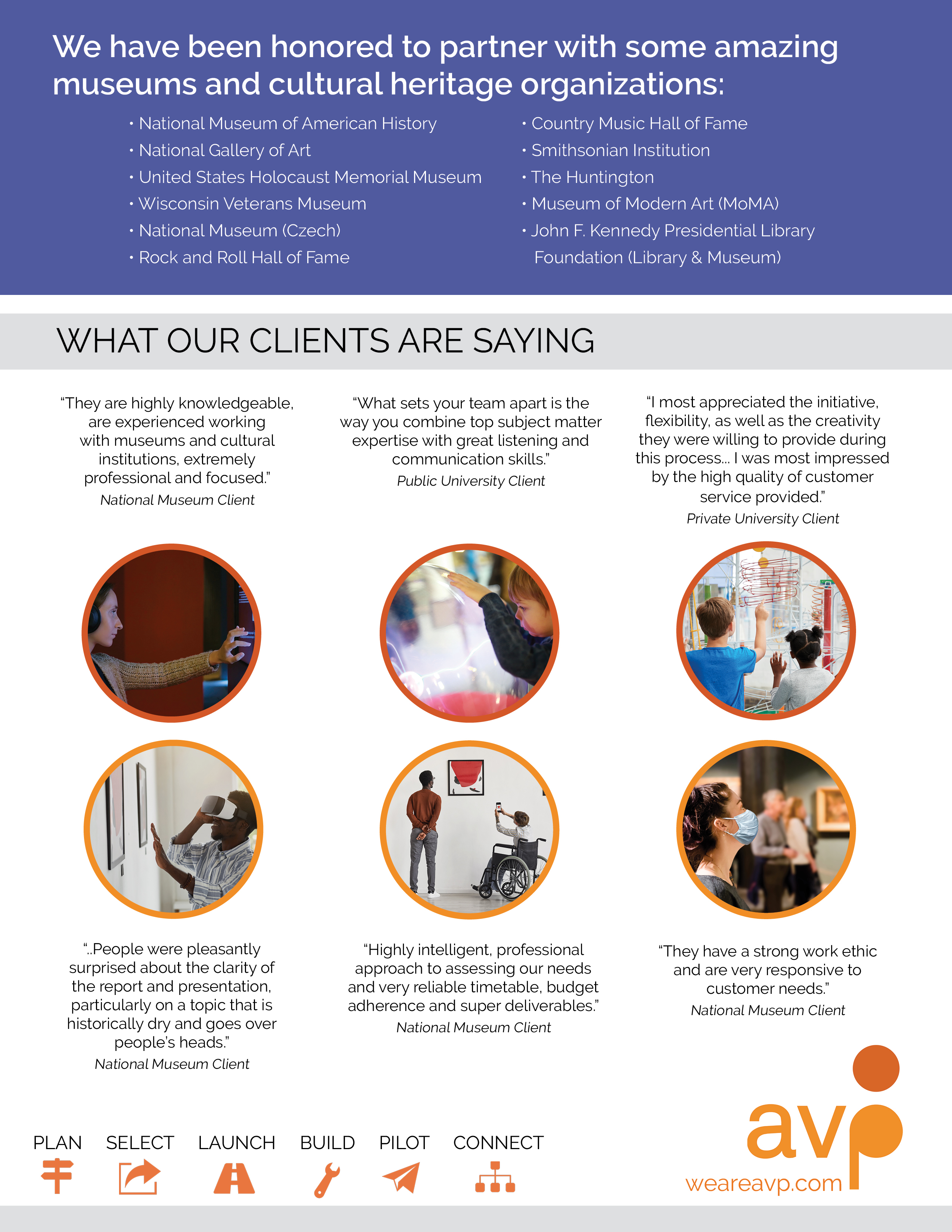
Put Your Digital Assets to Work
Ready to put your digital assets to work?
AVP’s approach to digital asset management encompasses digital preservation, digital collection management, DAM, and MAM to maximize the value of these assets to the organization and its internal and external users.
Free Digital Preservation Webinar With AVP
8 December 2021
Free Digital Preservation workshop with AVP:
“Digital Preservation Maturity Assessment with AVP’s Digital Preservation Go!”
December 7, 2021 at 1 PM ET
Join AVP for a free webinar that will introduce you to our newest and lowest-cost digital preservation assessment service. During the webinar, Senior Consultant Amy Rudersdorf will present on the benefits of maturity assessments and how performing them can move your digital preservation program to the next level. Sign up here and learn more about DPGo! below.
New from AVP: AVP’s Best DAM Workshop Series
27 August 2021
Let AVP’s expert facilitators help transform your data or digital asset management program, in just a few hours. Our workshops have proven results and are designed to breakthrough tough challenges quickly. Read more about our workshop offerings below and reach out to us at [email protected] to learn more.
Sign Up For Free DAM Workshop With AVP 08/17/21 @ 1PM ET
23 June 2021
Join AVP for a free, interactive, one-hour workshop on August 17 (@ 1 pm ET) designed to help you improve your users’ digital asset management experience. During the workshop, AVP Director of Consulting Kara Van Malssen will lead participants through user-centered exercises that DAM program leaders can utilize to create a more useful search, browse, discovery, and usability experience. In this workshop, you will learn how to:
- Understand users’ mental model of assets so that they can be organized and presented in meaningful ways
- Identify common search and browse terminology so that assets can be made findable in ways that match users’ search behavior
- Identify what users want to know about assets so that they can be effectively used
These exercises have proven results and are the same we use when engaging with our clients in diverse industries and organizational sizes.
Click here to apply for the workshop.
This workshop will be (virtually) hands-on and interactive, so come prepared to participate. Space is limited and registration is not guaranteed but we will do our best to accommodate interest. Limit 2 people per organization, please register separately.
Feel free to check out other helpful AVP resources for digital asset management.
- Designing a User-driven DAM Experience, Part 1
- Getting to Success: A Scenario-driven Approach for Selecting, Implementing, and Deploying Digital Asset Management Systems
- AVP Tips to Manage Your DAM Expectations Video
- Change is hard. Rally around your vision.
We know what it takes to implement and launch a successful DAM. Our experts are always two steps ahead to ensure that surprises and oversights are eliminated, your DAM implementation meets your needs, your launch is smooth, and your users are delighted. We offer implementation packages or can create a tailored service based on your needs. Ready to talk about your project? Get in touch!


